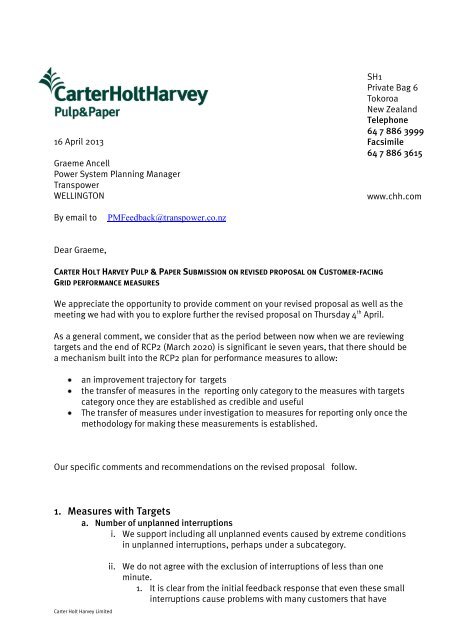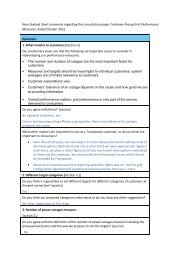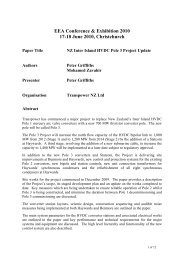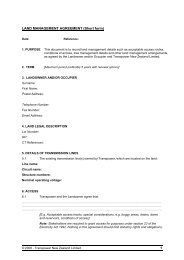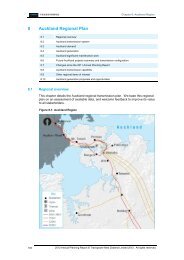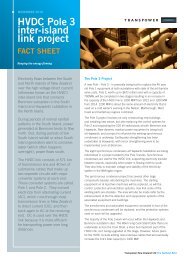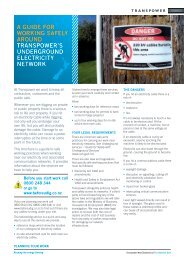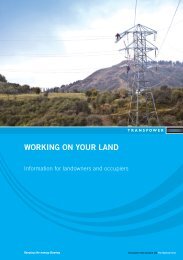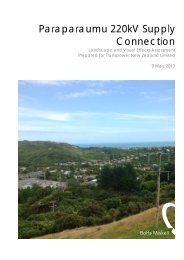Carter Holt Harvey Pulp and Paper - Transpower
Carter Holt Harvey Pulp and Paper - Transpower
Carter Holt Harvey Pulp and Paper - Transpower
- No tags were found...
Create successful ePaper yourself
Turn your PDF publications into a flip-book with our unique Google optimized e-Paper software.
16 April 2013Graeme AncellPower System Planning Manager<strong>Transpower</strong>WELLINGTONSH1Private Bag 6TokoroaNew Zeal<strong>and</strong>Telephone64 7 886 3999Facsimile64 7 886 3615www.chh.comBy email toPMFeedback@transpower.co.nzDear Graeme,CARTER HOLT HARVEY PULP & PAPER SUBMISSION ON REVISED PROPOSAL ON CUSTOMER-FACINGGRID PERFORMANCE MEASURESWe appreciate the opportunity to provide comment on your revised proposal as well as themeeting we had with you to explore further the revised proposal on Thursday 4 th April.As a general comment, we consider that as the period between now when we are reviewingtargets <strong>and</strong> the end of RCP2 (March 2020) is significant ie seven years, that there should bea mechanism built into the RCP2 plan for performance measures to allow:an improvement trajectory for targetsthe transfer of measures in the reporting only category to the measures with targetscategory once they are established as credible <strong>and</strong> usefulThe transfer of measures under investigation to measures for reporting only once themethodology for making these measurements is established.Our specific comments <strong>and</strong> recommendations on the revised proposal follow.1. Measures with Targetsa. Number of unplanned interruptionsi. We support including all unplanned events caused by extreme conditionsin unplanned interruptions, perhaps under a subcategory.<strong>Carter</strong> <strong>Holt</strong> <strong>Harvey</strong> Limitedii. We do not agree with the exclusion of interruptions of less than oneminute.1. It is clear from the initial feedback response that even these smallinterruptions cause problems with many customers that have
impacts similar to interruptions of longer duration, particularlythose in the High Priority <strong>and</strong> Important categories.2. We note that these short duration interruptions are alreadymeasured (see page 11 of your feedback response report) <strong>and</strong> thatthey number approximately 40% of the number of interruptionsgreater than 1 minute. It appears therefore that there can be noissue with measurement method or sufficiently underst<strong>and</strong>ing thehistory of short duration interruptions to allow realistic targets tobe set.3. We recommend that interruptions of less than one minute induration are included in the target number of unplanned outagesfor those GXPs in the High Priority <strong>and</strong> Important category. Thiscomprises only approximately 30% of all GXP/GIPs.iii. We support targets that include taking account of N security sites.iv. We note that you plan to define interruption levels that will triggerinvestigation, reporting <strong>and</strong> remedial action.1. Using the number of GXPs in the High Priority <strong>and</strong> importantcategories <strong>and</strong> the suggested target faults each year, it can beseen that the number of faults in these categories are likely to bein the order of 12 each year. Even when this number is increased by40% to account for interruptions of less than 1 minute, the totalinterruptions is likely to be around 17 each year. Given the impactof such interruptions on these GXPs, it seems quite reasonable toexpect that every interruption will trigger investigation, reporting<strong>and</strong> remedial action.2. We recommend that all interruptions for GXPs in the High Priority<strong>and</strong> Important categories (including those of less than one minute)will trigger investigation, reporting <strong>and</strong> remedial action.b. Duration of unplanned interruptionsi. We agree with reporting <strong>and</strong> setting targets for the duration ofinterruptions of greater than one minute only. We consider that it issatisfactory to measure <strong>and</strong> include in targets as per the recommendationin para 1(a) ii 3 above the number only of interruptions less than oneminute.2. Measures for reporting onlya. We support measuring the time a GXP is on N security of supply.
i. Our relatively localised experience indicates that there are two mainreasons why a supply to a GXP is moved to N security, namely for systemsecurity reasons or for maintenance (planned or unplanned).ii. Maintenance planning should take into account whether a change from N-1 to N security is required <strong>and</strong> the likely duration of the necessary gridreconfiguration as this is a period of known increased supply risk not onlybecause of the inherently increased risk on N security but also theincreased risk due to human intervention in both switching <strong>and</strong> the workitself.iii. The discipline of considering this risk when planning maintenance workwill improve both planning <strong>and</strong> execution of the work.iv. Information on the time a supply to a GXP is on N security for overallsystem security reasons should also provide guidance on areas wheregrid performance should be reviewed.v. We recommend that once a pattern of time on N security for plannedmaintenance is established after (as a suggestion 4 years from start ofmeasurement which could start in the 2014 year) , then that measure ismoved to the measure with target category.3. Performance measurement developmenta. Power Quality reportingi. Momentary interruptions1. As discussed above, it seems to us that this aspect is alreadymeasured so no further work appears to be necessary to include itin the measures with target category.ii. Momentary fluctuations.1. Power quality reporting industry working group.a. Thank you for establishing this group. We are sure it will bethe catalyst for underst<strong>and</strong>ing the cause <strong>and</strong> nature ofmomentary fluctuations ( brownouts) <strong>and</strong> their impact oncustomers.b. We will be happy to provide a person from CHH to assistwith this task.<strong>Carter</strong> <strong>Holt</strong> <strong>Harvey</strong> Limited
2. We underst<strong>and</strong> that the installation of new metering New Zeal<strong>and</strong>wide that is almost complete probably has the capability tomeasure momentary fluctuations. We further underst<strong>and</strong> thatcommunication systems to link the data from these meters to acentralised monitoring system is also under way3. Attached in the appendix is an excerpt from the latest Vector assetmanagement plan ( accessible from their website) which describestheir approach to measuring <strong>and</strong> performance targets formomentary fluctuations. While the measures <strong>and</strong> targetsdeveloped by Vector may not be suitable in the grid transmissioncontext, it is clear that this sort of measure is not entirely breakingnew ground, <strong>and</strong> no doubt, further searching the world on suchmeasures would locate additional useful guidance.4. We consider that taking into account the customer feedback onthis issue, there is good reason to progress this aspect ofmeasurement in a timely manner.5. We recommend that the first meeting of the working groupdevelops a plan with timing to establish <strong>and</strong> put into action themonitoring of momentary fluctuations at GXPs that are identifiedas susceptible to these fluctuations.6. We also recommend that a date is set to include this measure inthe measures without targets category during RCP2.b. Reporting financial impact of interruptions.i. We support the proposed use of the Electricity Authority work presentlyunder development in establishing improved VOLL measurements as abasis for reporting <strong>and</strong> eventually developing economic impact targets.ii. The use of improved VOLL measures in their application to actual lossesof load should also provide a very useful basis for developingimprovement plans that would include appropriately targeted enhancedmaintenance work <strong>and</strong> capital expenditure.iii. We consider that work to establish the use of this measure in the revisedcustomer facing measures should also have a timing planiv. We recommend that a project timeline be developed in conjunction withthe Commerce Commission, Electricity Authority, <strong>Transpower</strong> <strong>and</strong>customers to allow the use of economic impact on customers on loss ofsupply to be included in the measures without targets category duringRCP2.
4. GXP Categories.a. We note that two of the GXPs at the Kinleith substation are in the “important”category which we believe is appropriate.b. However, the third GXP (KIN0111) also provides supply to the CHH Mill so is also akey N security load <strong>and</strong> so should be included in the “Important” category.c. We recommend that loads that are sensitive to momentary fluctuations in quality<strong>and</strong>/or are at N security are included as “key loads” when evaluating thecategory each GXP should be in . Loads with either or both these characteristicsmay well be more affected by both fluctuations <strong>and</strong> losses than the more generaltypes of loads.Thank you for the opportunity to contribute to this very important aspect of delivery ofelectricity to customers.Yours sincerelyLyndon HaughEnergy Manager<strong>Carter</strong> <strong>Holt</strong> <strong>Harvey</strong> <strong>Pulp</strong> & <strong>Paper</strong> LtdLyndon.Haugh@chh.co.nzPh 07 88557790274 446 708<strong>Carter</strong> <strong>Holt</strong> <strong>Harvey</strong> Limited
Appendix – Vector Asset management plan section on momentary voltage sagsMeasures <strong>and</strong> targets
<strong>Carter</strong> <strong>Holt</strong> <strong>Harvey</strong> Limited


